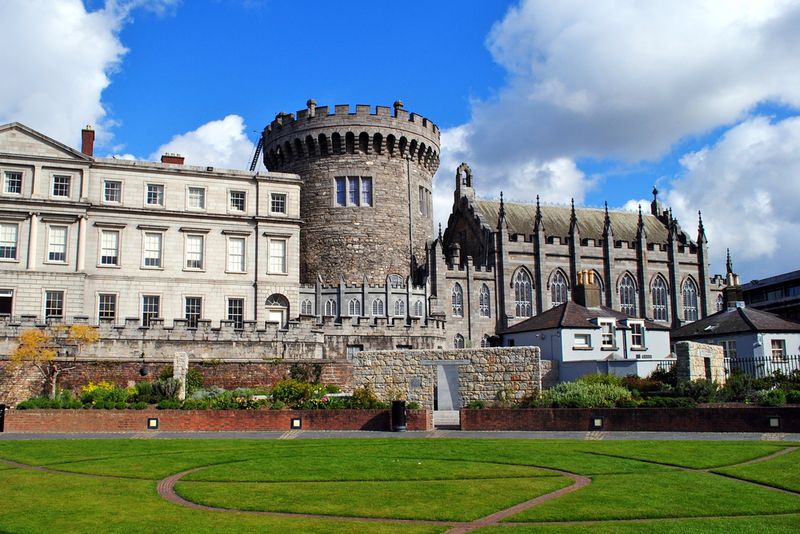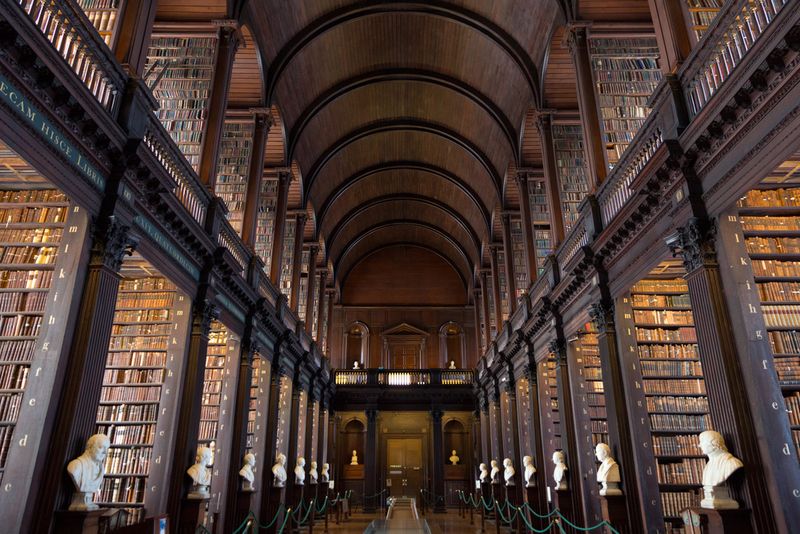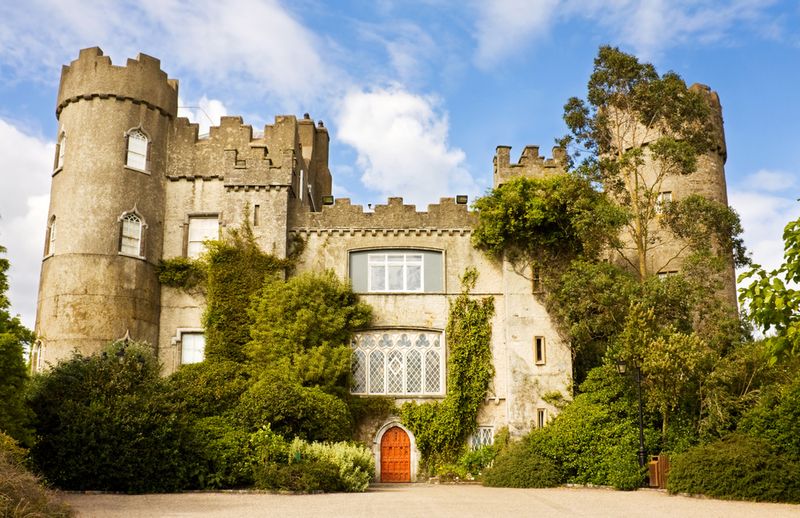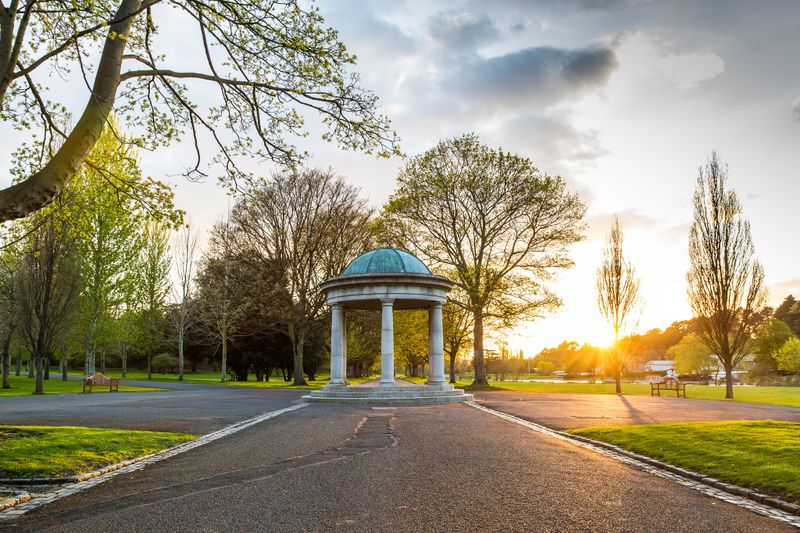
Dublin, Ireland is a land of natural beauty, rolling landscapes, and picturesque hillsides. The temperate weather and frequent foggy patches give the land an almost mystical effect. Scores of tourists flock to the region each year to learn about the rich history and enjoy all the attractions that the land has to offer. There are literally hundreds of ancient artifacts, famous landmarks, and monuments of historical importance that people add to their must see lists. The striking combination of ancient structures and modern architecture make Ireland an ever popular tourist attraction. Since it would be nearly impossible to see everything worthwhile in one brief visit to Dublin, these are some of the top spots that should be a priority on the list of exhibits and attractions.
Advertisement
1. Dublin Castle
Since construction completed in 1204, this original Celtic settlement structure has been in continuous use. Today, the city center enjoys a prominent location that is used for important conferences, events, and fine dining for the elite. If these walls could talk, they would spill secrets of invasions, espionage, famine, and the occasionally peaceful and wealthy rule. The elaborately decorated and internationally notorious state rooms are open to the public for guided tours and give visitors a glimpse into the past and an idea about how royal families may have managed their daily lives. In a land full of historic landmarks and stone castles, the Dublin Castle is considered an original.

2. National Museum of Ireland
The national museum features four total branches, three of which are located in Dublin. Archaeology, Decorative Arts and History, and the Natural History Museum buildings are within walking distance of other major Dublin attractions. The collections found here are entertaining, enlightening, and awe inspiring. Dedicating an entire day to these sites provides visitors with a thorough understanding of the interesting history of Ireland, as well as the sometimes dark side of Irish politics, and a lighthearted look at the age old customs, rituals, and cultural aspects that still have significant impact on every generation of Irish decent.

3. St Patrick’s Cathedral
Founded in 1911, the National Cathedral and Collegiate Church of Saint Patrick, Dublin has been a staple of the history and religious affiliations of the country since Saint Patrick baptized the first Christian convert in the makeshift outdoor baptismal. This historical landmark played a significant role in the history of Ireland and is still the largest cathedral in the country. Daily tours permit visitors to walk through hallowed hallways and discover the history of a building that withstood storms, fires, neglect, and even persecution over an 800 year period. Visitors are also welcome to stay for one of the daily worship services and experience an authentic period of devout worship in the traditional stained glass chapel.

4. Trinity College Library
In 1592, by way of a royal charter, the Trinity College Dublin was formed in an effort to educate professionals, mostly clergymen. The trend throughout much of Western Europe at the time was away from conquering and on to civilization. Royal families believed that territories with sufficient educational resources would appear wealthy and superior to surrounding countries. Now considered part of the University of Dublin group, many of the buildings from the Trinity College Dublin still stand today. The library rivaled those found in Oxford and Cambridge, and offers an innovated place for students to study for their undergraduate exams and graduate level entrance exams. The library is open to the public most days, but restricts visiting hours for non-student visitors during periods of final exam preparation.

Advertisement
5. Ardgillan Castle
Situated just about 20 miles from the city of Dublin, the picturesque Ardgillan Castle is an absolute must see for any tourist or resident of Ireland. Building began in 1738 by the Robert Taylor family, and continuous construction of the estate produced the meandering country home that spans nearly 200 acres. The country style residence was used by the family for many generations and today represents one of the most popular public parks and playground facilities on the island. The breathtaking views of the Irish Sea and Mourne Mountains make the facility a famous location for weddings and business conferences.

6. National Gallery of Ireland
Art lovers must make a stop at Merrion Square to take in all the culture and fine art establishments, especially the National Gallery of Ireland. The decidedly modern architectural structure was founded in 1854 and opened to the public in 1864. The gallery is famous for its world renowned collection of Irish and European art, namely some of the only Dutch masters paintings. The national collections include permanent pieces and famous exhibits from around the world that are displayed randomly while on loan from other galleries and museums. The gallery is open to the public and admission is free.

7. Kilmainham Gaol
The infamous former prison built in 1796 represents a period of history in Ireland that is unpleasant but formative. Many prisoners housed here were part of the various rebellious movements and some were executed under British and Irish Free State rulers who wanted to squash the independent rebellions. Today, the facility is still in use as a government agency building and a museum that is open for public guided tours. Visitors can view in eerie detail the way prisoners roamed through hallways and metal staircases under the watchful eye of prison guards. History and political buffs will definitely want to make a stop at the Kilmainham Gaol.

8. Christ Church Cathedral
Originally founded in 1028, the Cathedral of the Holy Trinity contains one of the oldest structures in all of Great Britain. Commonly known as the Christ Church Cathedral, the property houses the famous underground crypts which have been an important pilgrimage site since medieval times. The mysterious monuments and resting places far below the surface of the foundation are still one of the most popular tourist attractions for people who love the historical, religious, and cultural aspects of Ireland. Both the cathedral and the crypts are open to the public for worship services, event rentals, and public tours.

9. Malahide Castle
The Malahide Castle and Gardens recently underwent restoration to preserve the natural history and architecture of the world famous tourist attraction. Situated along the north coast of Dublin, the castle was home to the Talbot family for centuries before the land was donated to the country for public use. The traditional stone structure and drafty rooms are reminiscent of ancient times, while the beautiful courtyards and gardens offer visitors a chance to stop and enjoy the scenery. More than 5,000 plant and flower species can be found in the gardens, and visitors are invited to admire their beauty while enjoying afternoon tea and refreshments from the courtyard.

Advertisement
10. Irish National War Memorial Gardens
Located in Islandbridge, Dublin, the National War Memorial Gardens is a beautiful but somber memorial. The property is dedicated to the nearly 50,000 Irish soldiers who sacrificed their lives during The Great War from 1914-1918. The First World War had such an earth shattering impact throughout Europe that various countries sought a suitable way to pay homage to those who lost their lives. The Central Lawn, Sunken Rose Garden, The Avenues, and The North Terrace are each expertly designed and painstakingly maintained by the Office of Public Works in an effort to provide the world a chance to salute the lost soldiers and quietly reflect on the recent past.

Advertisement